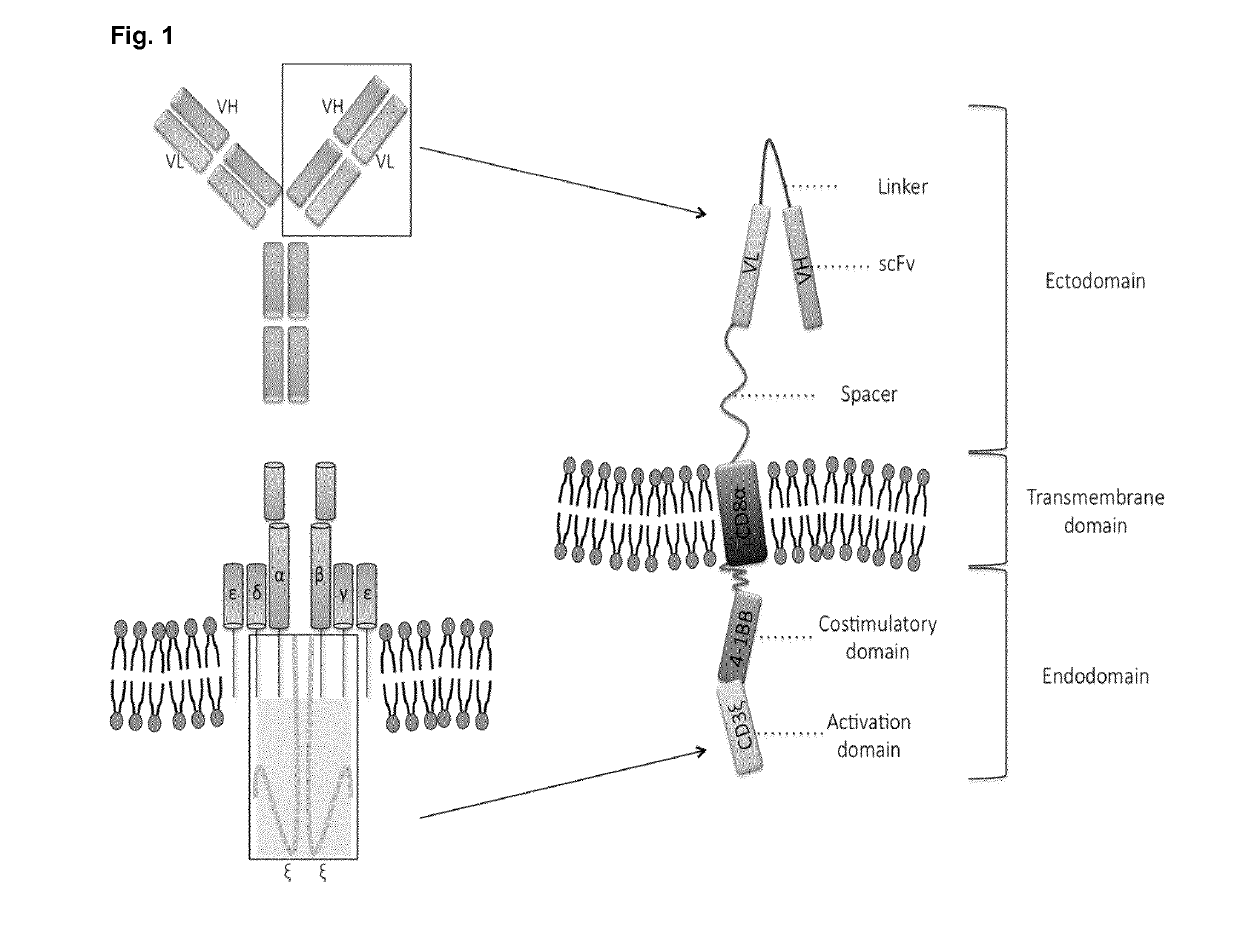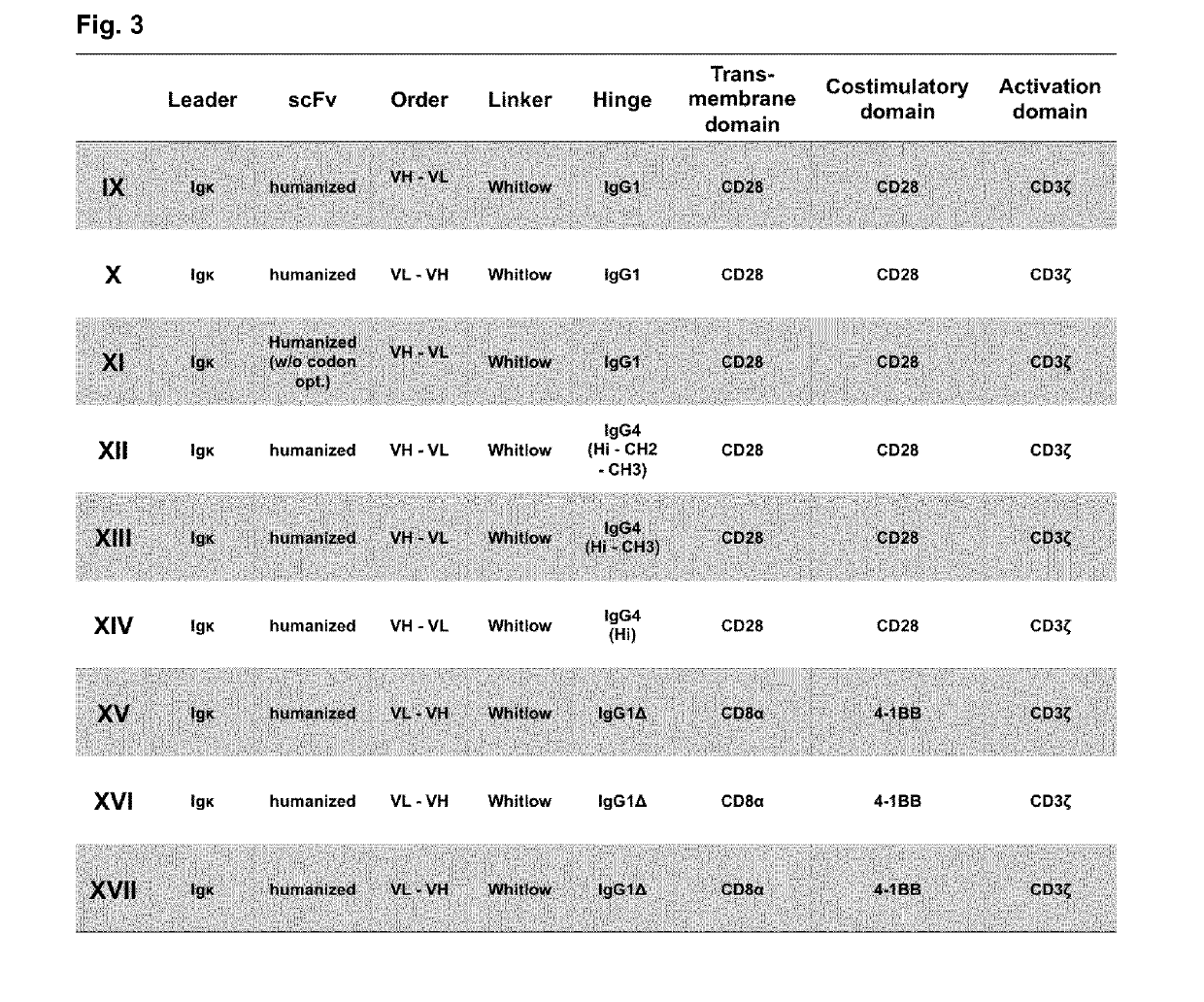Chimeric antigen receptor and car-t cells that bind bcma
a technology of chimeric antigen receptor and cart cells, which is applied in the direction of genetically modified cells, immunological disorders, drug compositions, etc., can solve the problems of unsuitability of rituximab, high infection risk, and secondary resistance, and achieves minimal bcma expression, high specificity, and high affinity
- Summary
- Abstract
- Description
- Claims
- Application Information
AI Technical Summary
Benefits of technology
Problems solved by technology
Method used
Image
Examples
example 1
nd Plasmid Preparation
[0373]CAR sequences were synthesized using GeneArt™ (Gene Synthesis Service). Restriction digestion of the CAR construct was carried out using NotI and EcoRI (FIG. 5). The retroviral vector MP71 was also digested with NotI and EcoRI, and subsequently dephosphorylated.
[0374]The CAR and vector were separated using gel electrophoresis (FIG. 6.) and the fragments were purified. The CAR construct was subsequently ligated into the vector (50 ng) at a ratio of 3:1. Transformation of the ligation mixture into MACH-1 was carried out (FIG. 3.). A control digest was conducted and the Mini-Preparation was sequenced. The constructs were subsequently re-transformed into MACH-1. A maxi-Preparation of the MP71-BCMA-CAR plasmid was produced.
[0375]MP71 is a single (+)-strand-RNA-Virus. Reverse-Transcriptase converts the retroviral RNA-Genome into a DNA copy. The DNA integrates as a provirus at a random position into the target genome. Through cell division the virus reproduces s...
example 2
ion and Transduction
[0376]Day 0: Seeding HekT(293T)- or GalV-cells for virus production in 6 well plates
[0377]Day 1: Transient 3-plasmid transfection for retrovirus production (calcium phosphate transfection). Per well, 18 pg of DNA was used, in 250 mM Cacl2, 150 μl H2O, according to standard protocols. Cells are incubated for 6 h at 37° C., medium is exchanged, further incubation carried out for 48 h at 37° C.
[0378]Coating of 24-Well Non-Tissue Culture Plates with Anti-huCD3 and Anti-huCD28 Antibodies:
[0379]Prepare anti-CD3 / anti-CD28-antibody solution in PBS (5 pg / ml anti-CD3, 1 pg / ml anti-CD28), 0.5 ml per well. Incubate each well with 0.5 ml antibody solution for 2 h at 37° C., replace with sterile 2% BSA-solution (in water), incubation: 30 min (37° C.). Remove BSA-solution and wash wells with 2 ml PBS.
[0380]Purification of PBMCs from 40 ml Blood (˜2.5×107 PBMCs):
[0381]Prepare 12.5 ml Ficoll-Gradient medium in 2×50 ml Falcon-Tube, dilute blood with RPMI (+100 IU / ml Penicillin, St...
example 3
l In Vitro Testing of Anti-BCMA CAR T Cells
[0390]I. Confirmation of BCMA CAR-Expression on Human T Cells Following Retro Viral Transduction.
[0391]Evidence was obtained of folding and transport of the CAR receptor in context of human T cells; the functionality of retrovirus transduction protocol was assessed.
[0392]Human peripheral blood leukocytes were purified via a Ficoll gradient. Cells were cultured, stimulated and retrovirally transduced as described above. Following transduction, cells were further cultured in either IL-2 or IL-7 / IL-15 containing medium prior to the analysis of BCMA-CAR expression.
[0393]Transduction rate and viability were assessed by flow cytometry (FACS) analysis. To detect BCMA-CAR expression, cells were stained with anti-human Ig-antibody that recognizes selectively the human IgG1 or IgG4 section in the spacer region of the CAR construct. A co-staining for CD3 / CD8 / CD4 T cells was performed. For the results refer to FIG. 7.
[0394]II. Co-Cultures of CAR-Transd...
PUM
| Property | Measurement | Unit |
|---|---|---|
| concentration | aaaaa | aaaaa |
| concentration | aaaaa | aaaaa |
| width | aaaaa | aaaaa |
Abstract
Description
Claims
Application Information
 Login to View More
Login to View More - R&D
- Intellectual Property
- Life Sciences
- Materials
- Tech Scout
- Unparalleled Data Quality
- Higher Quality Content
- 60% Fewer Hallucinations
Browse by: Latest US Patents, China's latest patents, Technical Efficacy Thesaurus, Application Domain, Technology Topic, Popular Technical Reports.
© 2025 PatSnap. All rights reserved.Legal|Privacy policy|Modern Slavery Act Transparency Statement|Sitemap|About US| Contact US: help@patsnap.com



